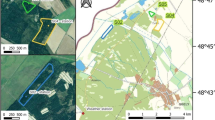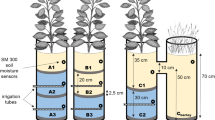Abstract
The aim of this study was to investigate transpiration and its main driving factors on the example of a hybrid poplar plantation with the clone Populus maximowiczii × P. nigra, cv. Max 1 on a site in the hilly loess region of Saxony (Germany). Transpiration was measured using sap flow techniques during the 2007 and 2008 growing season. At the same time, throughfall, soil moisture dynamics and soil physical properties were also measured. Total transpiration rates amounted to 486 mm and 463 mm, respectively, during the 2 years. Maximum daily transpiration rates reached 6.7 mm/day, while an average of 2.2 mm/day for the entire growing season was recorded. The main controlling factors for stand transpiration included the evaporative demand, water availability and soil temperature. The information was implemented into a simple empirical model for the prediction of transpiration. It can be concluded that large-scale establishment of poplar plantations will result in a distinct reduction in groundwater recharge. On the other hand, surface run-off and soil erosion may decrease. Due to limited water availability in the late growing season, the growth potential of the tested clone cannot fully be exploited at many sites in Germany.






Similar content being viewed by others
Abbreviations
- ETP:
-
Potential evapotranspiration over grass
- LAI:
-
Leaf area index
- REW:
-
Root extractable water [fraction]
- T:
-
Stand transpiration
- Tn:
-
Stand transpiration normalised by LAI
- Ts:
-
Soil temperature
References
Allen RG, Pereira LS, Raes D, Smith M (1998) Crop evapotranspiration: guidelines for computing crop water requirements. FAO Irrigation and Drainage Paper no. 56, Rome, Italy
Allen SJ, Hall LR, Rosier PTW (1999) Transpiration by two poplar varieties grown as coppice for biomass production. Tree Physiol 19:493–501
Bernier PY, Bredá N, Granier A, Raulier F, Mathieu F (2002) Validation of a canopy gas exchange model and derivation of a soil water modifier for transpiration for sugar maple (Acer saccharum Marsh.) using sap flow density measurements. For Ecol Manage 163:185–196
Blake TJ, Sperry JS, Tschaplinski TJ, Wang SS (1996) Water relations. In: Stettler RF, Bradshaw HD, Heilman PE, Hinckley TM (eds) Biology of populus and its implications for management and conservation. NRC Research Press, Ottawa, Ontario, pp 401–422
Böhm W (1979) Methods for studying root systems. Ecological studies Vol. 33. Springer-Verlag, Berlin
Braatne JH, Hinckley TM, Stettler RF (1992) Influence of soil water on the physiological and morphological components of plant water balance in Populus trichocarpa, Populus deltoides and their F1 hybrids. Tree Physiol 11:325–339
Braatne JH, Rood SB, Heilman PE (1996) Life history, ecology, and conservation of riparian cottonwoods in North America. In: Stettler R, Bradshaw H Jr, Heilman P, Hinckley T (eds) Biology of populus and its implications for management and conservation. NRC Research Press, Ottawa, pp 57–85
Bungart R, Hüttl R (2004) Growth dynamics and biomass accumulation of 8-year-old hybrid poplar clones in a short-rotation plantation on a clayey-sandy mining substrate with respect to plant nutrition and water budget. Eur J Forest Res 123(2):105–115
Cade BS, Noon BR (2003) A gentle introduction to quantile regression for ecologists. Front Ecol Environ 1:412–420
Čermák J, Nadezhdina N (1998) Sapwood as the scaling parameter—defining according to xylem water content or radial pattern of sap flow? Ann Sci For 55:509–521
Čermák J, Deml M, Penka M (1973) A new method of sap flow rate determination in trees. Biol Plant 15:171–178
Čermák J, Kučera J, Nadezhdina N (2004) Sap flow measurement with some thermodynamic methods, flow integration within trees and scaling up from sample trees to entire forest stands. Trees 18:529–546
Cohen Y, Cohen S, Cantuarias-Aviles T, Schiller G (2008) Variations in the radial gradient of sap velocity in trunks of forest and fruit trees. Plant Soil 305:49–59
Coté B, Hendershot WH, Fyles JW, Roy AG, Bradley R, Biron PM, Courchesne F (1998) The phenology of fine root growth in a maple-dominated ecosystem: relationships with some soil properties. Plant Soil 201:59–69
EMS (2006) Sap flow system using LT 51.1 modules—instruction manual. Brno
Eriksson H, Eklundh L, Hall K, Lindroth A (2005) Estimating LAI in deciduous forest stands. Agric For Meteorol 129:27–37
Ewers BE, Mackay DS, Tang J, Bolstad PV, Samanta SS (2008) Intercomparison of sugar maple (Acer saccharum Marsh.) stand transpiration responses to environmental conditions from the Western Great Lakes region of the United States. Agric For Meteorol 148:231–246
Granier A, Loustau D, Bredá N (2000) A generic model of forest canopy conductance dependent on climate, soil water availability and leaf area index. Ann For Sci 57:755–765
Haferkorn U (2000) Größen des Wasserhaushaltes verschiedener Böden unter landwirtschaftlicher Nutzung im klimatischen Grenzraum des Mitteldeutschen Trockengebietes, Ergebnisse der Lysimeterstation Brandis. Dissertation, University of Göttingen
Hall RL, Allen SJ, Rosier PTW, Smith DM, Hodnett G, Roberts JM, Hopkins R, Davies HN (1996) Hydrological effects of short rotation energy coppice. Final report to ETSU. Institute of Hydrology, Wallingford
Hall RL, Allen SJ, Rosier PTW, Hopkins R (1998) Transpiration from coppiced poplar and willow measured using sap-flow methods. Agric For Meteorol 90:275–290
Hinckley TM, Brooks JR, Čermák J, Ceulemans R, Kučera J, Meinzer FC, Roberts DA (1994) Water flux in a hybrid poplar stand. Tree Physiol 14:1005–1018
Jug A, Hoffmann-Schielle C, Makeschin F, Rehfuess KE (1999) Short rotation plantations of balsam poplars, aspen and willows on former arable land in the Federal Republic of Germany. II. Nutritional status and bioelement export by harvest of shoot axes. For Ecol Manage 121:67–83
Kelliher FM, Leuning R, Raupach MR, Schulze ED (1995) Maximum conductances for evaporation from global vegetation types. Agric For Meteorol 73:1–16
Kim HS, Oren R, Hinckley TM (2008) Actual and potential transpiration and carbon assimilation in an irrigated poplar plantation. Tree Physiol 28:559–577
Koenker R (2005) Quantile regressions. Econometric Society Monographs 38. Cambridge University Press
Kučera J, Čermak J, Penka M (1977) Improved thermal method of continual recording the transpiration flow rate dynamics. Biol Plant 19:413–420
Levia DF, Frost EE (2003) A review and evaluation of stem flow literature in the hydrologic and biogeochemical cycles of forested and agricultural ecosystems. J Hydrol 274:1–29
Linderson ML, Iritz Z, Lindroth A (2007) The effect of water availability on stand-level productivity, transpiration, water use efficiency and radiation use efficiency of field-grown willow clones. Biomass Bioenergy 31:460–468
Lyr H (1996) Effect of the root temperature on growth parameters of various European tree species. Ann Sci For 53:317–323
Meiresonne L, Nadezhdina N, Čermak J, Van Slycken J, Ceulemans R (1999) Measured sap flow and simulated transpiration from a poplar stand in Flanders (Belgium). Agric For Meteorol 96:165–179
Mellander PE, Bishop K, Lundmark T (2004) The influence of soil temperature on transpiration: a plot scale manipulation in a young Scots pine stand. For Ecol Manage 195:15–28
Mellander PE, Stähli M, Gustafsson D, Bishop K (2006) Modelling the effect of low soil temperatures on transpiration by Scots pine. Hydrol Processes 20:1929–1944
Monclus R, Dreyer E, Villar M, Delmotte FM, Delay D, Petit JM, Barbaroux C, le Thiec BC, Brignolas F (2006) Impact of drought on productivity and water use efficiency in 29 genotypes of Populus deltoides × nigra. N Phytologist 169:765–777
Oren R, Sperry JS, Katul GG, Pataki DE, Ewers BE, Phillips N, Schäfer KVR (1999) Survey and synthesis of intra- and interspecific variation in stomatal sensitivity to vapour pressure deficit. Plant Cell Environ 22:1515–1526
Phillips N, Oren R (1998) A comparison of daily representations of canopy conductance based on two conditional time averaging methods and the dependence of daily conductance on environmental factors. Ann Sci For 55:217–235
Poyatos R, Llorens P, Gallart F (2005) Transpiration of montane Pinus sylvestris L. and Quercus pubescens Willd. forest stands measured with sap flow sensors in NE Spain. Hydrol Earth Syst Sci 9:493–505
Pregitzer KS, King JS, Burton AJ, Brown S (2000) Responses of tree fine roots to temperature. N Phytologist 147:105–115
Richter D (1995) Ergebnisse methodischer Untersuchungen zur Korrektur des systematischen Meßfehlers des Hellmann-Niederschlagmessers. Berichte des Deutschen Wetterdienstes 194, Offenbach
R Development Core Team (2008) R: a language and environment for statistical computing. R Foundation for Statistical Computing, Vienna, Austria. ISBN 3-900051-07-0, URL http://www.R-project.org
Schwärzel K, Menzer A, Clausnitzer F, Spank U, Häntzschel J (2009) Soil water content measurements deliver reliable estimates of water fluxes: a comparative study in a beech and a spruce stand in the Tharandt forest. Agric For Meteorol 149:1994–2006
Souch CA, Stephens W (1998) Growth, productivity and water use in three hybrid poplar clones. Tree Physiol 18:829–835
Stephens W, Hess T, Knox J (2001) Review of the effects of energy crops on hydrology. Report to MAFF. Institute of Water and the Environment, Cranfield University, Silsoe
Tatarinov FA, Kučera J, Cienciala E (2005) The analysis of physical background of tree sap flow measurement based on thermal methods. Measurement Sci Technol 16:1157–1169
Volk TA, Verwijst T, Tharakan PJ, Abrahamson LP, White EH (2004) Growing fuel: a sustainability assessment of willow biomass crops. Front Ecol Environ 2(8):411–418
Zalesny RS, Hall RB, Bauer EO, Riemenscheider DE (2005) Soil temperature and precipitation affect the rooting ability of dormant hardwood cuttings of populus. Silvae Genetica 54(2):47–58
Zhang H, Morison JIL, Simmonds LP (1999) Transpiration and water relation of poplar trees growing close to the water table. Tree Physiol 19(9):563–573
Acknowledgments
We like to express our thanks to J. Kučera (Brno) for his introduction to sap flow techniques and fruitful discussions, U. Haferkorn (Lysimeter station Brandis) and the Department of Meteorology, TU Dresden for providing additional lysimeter and eddy-flux data. The study was financially supported by the Federal Ministry of Education and Research (BMBF, project AGROWOOD - 0330710 A).
Author information
Authors and Affiliations
Corresponding author
Additional information
Communicated by R. Matyssek.
Rights and permissions
About this article
Cite this article
Petzold, R., Schwärzel, K. & Feger, KH. Transpiration of a hybrid poplar plantation in Saxony (Germany) in response to climate and soil conditions. Eur J Forest Res 130, 695–706 (2011). https://doi.org/10.1007/s10342-010-0459-z
Received:
Revised:
Accepted:
Published:
Issue Date:
DOI: https://doi.org/10.1007/s10342-010-0459-z




